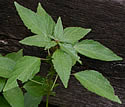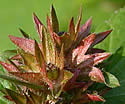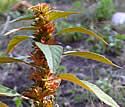Acalypha rhomboidea (Three-seeded Mercury)
| Also known as: | Rhombic Copperleaf |
|---|---|
| Genus: | Acalypha |
| Family: | Euphorbiaceae (Spurge) |
| Life cycle: | annual |
| Origin: | native |
| Habitat: | part shade, sun; disturbed soil, waste places |
| Bloom season: | June - October |
| Plant height: | 8 to 24 inches |
| Wetland Indicator Status: | GP: FACU MW: FACU NCNE: FACU |
| MN county distribution (click map to enlarge): |  |
| National distribution (click map to enlarge): |  |
Pick an image for a larger view. See the glossary for icon descriptions.
Detailed Information
Flower: 

![[photo of flowers]](/udata/r9ndp23q/pd/acalypha-rhomboidea-2-t.jpg) Tiny petal-less flowers form in dense clusters of palmately lobed, leafy bracts at the leaf axils, with separate male and female flowers. The yellowish to brown male (staminate) flowers are on a short stalk with 2 to 3 green female (pistillate) flowers at the base of the stalk in the center of bract. The lobes of the bracts are irregular, lance-like with pointed tips. ranging in color from light green to deep coppery-red and may be smooth but often with scattered hairs, especially along the edges and undersides.
Tiny petal-less flowers form in dense clusters of palmately lobed, leafy bracts at the leaf axils, with separate male and female flowers. The yellowish to brown male (staminate) flowers are on a short stalk with 2 to 3 green female (pistillate) flowers at the base of the stalk in the center of bract. The lobes of the bracts are irregular, lance-like with pointed tips. ranging in color from light green to deep coppery-red and may be smooth but often with scattered hairs, especially along the edges and undersides.
Leaves and stems: 

![[photo of leaves]](/udata/r9ndp23q/pd/acalypha-rhomboidea-1-t.jpg) Leaves are 1 to 4 inches long, up to 1 inch wide, mostly oval to lance-like tending towards rhombic angles, sparsely hairy, with long slender stalks that can be more than half as long as the leaf blade. The edges are serrated with shallow, blunt teeth. Leaves may appear almost whorled at the end of the stem but they are merely tightly packed, alternately attached. Leaves are typically medium to dark green but the plant can become deep coppery red, especially the stems, bracts and undersides of leaves. Stems are erect, hairless or somewhat hairy, mostly unbranched with the occasional short flowering side branches.
Leaves are 1 to 4 inches long, up to 1 inch wide, mostly oval to lance-like tending towards rhombic angles, sparsely hairy, with long slender stalks that can be more than half as long as the leaf blade. The edges are serrated with shallow, blunt teeth. Leaves may appear almost whorled at the end of the stem but they are merely tightly packed, alternately attached. Leaves are typically medium to dark green but the plant can become deep coppery red, especially the stems, bracts and undersides of leaves. Stems are erect, hairless or somewhat hairy, mostly unbranched with the occasional short flowering side branches.
Notes:
Three-seeded Mercury is a common native of abandoned lots, roadsides, railroads, and disturbed soil. A number of plants volunteered in my own backyard garden. It is generally considered a weedy species, but does not take over areas like invasive species do. Pennsylvania Pellitory (Parietaria pensylvanica) is similar in structure, but is a smaller plant with toothless leaves.
Native Plant Nurseries, Restoration and Landscaping Services ↓
More photos
Photos courtesy Peter M. Dziuk taken in Anoka County.
Comments
Have you seen this plant in Minnesota, or have any other comments about it?
on: 2015-08-26 22:14:06
I looked through every plant in Peterson's guide to wildflowers and finally found it and checked it against your site. Thanks. These are in many locations in my yard.
on: 2017-07-31 08:30:21
Have been beating my head against the wall for years on this plant...finally got it...joined a plant discussion group on Facebook...its been in my landscaping around our house for years...its a little comforting to know that it is native.
on: 2018-09-02 20:18:08
It is all over my yard this year. Any place there is a bare area, it is coming up. I recall seeing a little of it other years. But nothing like this year.
on: 2019-07-17 19:22:32
This plant presents a problem for me. I cannot remember ever seeing a mature plant in any garden of mine. It's never pretty, but annoyingly abundant. I have been pulling every seedling I see, but it still somehow shows up again and again. Now that I have FINALLY identified it, and it appears to be native, what should I do? Does it have any truly useful purpose? My solution: if it is as prolific as it appears to be, it will survive in the world, whether I pull it or not, and probably just right outside my property line. Thus, in this unusual case, I choose aesthetic value as the saving characteristic in my little piece of the world, and so out it's plain, relatively ugly seedlings go.
on: 2019-07-17 21:40:41
Mike, just because it's native doesn't mean it's desirable. :-)
on: 2019-07-28 09:33:53
think of this plant as a bothersome weed. not happy with how it appears everywhere in my perrenial garden. do I just accept it or is there a solution other than pulling the many plants
on: 2019-08-27 14:30:37
I am wondering if this plant, once Fall comes, produces burrs that are catching in my dog's hair? If not I will take joy in the fact they will turn colorful in the fall and I'll not pull them out so much! I live on a farm, so my landscape is natural, and I like it that way.
on: 2020-06-27 16:51:33
I think I have these too. Many grow, but many seem to die, they get spots on the leaves and many die out or just Shrivel and stop growing. But there are a lot of them. Very hard to find or locate and determine what these plants are using the internet.
on: 2020-08-25 18:44:01
My backyard chickens absolutely love this stuff, as much as scratch grains!
on: 2022-07-16 12:44:06
Do the seedlings look just like large-leaved aster seedlings? I planted lots of large-leaved aster seeds in May from a reputable in-state dealer, but the only seedlings I find (and lots of them) fit the description of Three-Seeded Mercury, and are ID'd on PictureThis as 3-seeded-mercury. Thanks!
on: 2022-07-18 10:05:26
Betsy, large-leaved aster requires 60 days of cold-moist stratification so if you spread seed in May it would not be germinating yet, but should next spring after the winter freeze-thaw cycle. Depending on how you prepped the soil, you could have disturbed weed seed that was already there.
on: 2022-09-25 14:37:34
We have Three Sided Mercury that has come up in many of our potted plants and throughout our property, as well. I have no problem with it and often let it grow wherever it decides to come up, including our other potted plants. I don't find it to be too much of a pest, and after all, it is native to Minnesota. I do not see it occurring in Pope County on the above map, but it is certainly here now, if it wasn't before. It looks like it occurs in Stearns County however, so I don't suppose it is too surprising to see it here in rural Pope County. Thank you for a wonderful and excellent website. It has been such a great help in helping me identify so many different plants.
on: 2023-07-13 19:39:18
This plant volunteers in my yard but not in a big way. In researching it further, evidently large seed-eating birds, i.e., the Greater Prairie Chicken, like the seeds of this plant. So it makes sense what Sue writes re: her backyard chickens' love of it.
on: 2023-09-20 10:03:51
This is prevalent in my back yard this year, and my dog suddenly has severe dermatitis. Does anyone else see skin allergies with their dogs and this weed? Thanks!
on: 2023-10-26 10:25:58
Can you dry it out and smoke it or can you eat it
on: 2023-10-26 10:33:49
Sharon, I imagine you can dry out and smoke any plant, but the effects of doing so are not documented for most species, including this one. BTW, don't try it with poison ivy. ;-)







 Three-seeded Mercury plant
Three-seeded Mercury plant coppery colored bracts
coppery colored bracts more plants
more plants